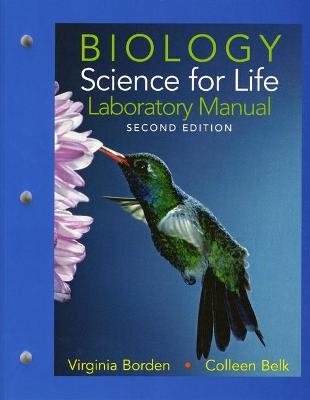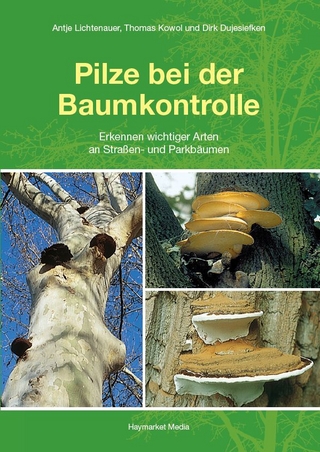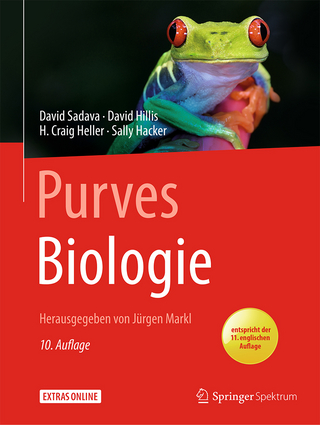
Laboratory Manual for Biology
Pearson (Verlag)
978-0-13-188804-3 (ISBN)
Colleen Belk and Virginia Borden Maier collaborated on teaching biology to nonmajors for over a decade at the University of Minnesota—Duluth. This collaboration has continued for an additional decade through Virginia’s move to St. John Fisher College in Rochester, New York, and has been enhanced by their differing but complementary areas of expertise. In addition to the nonmajors course, Colleen Belk teaches general biology for majors, genetics, cell biology, and molecular biology courses. Virginia Borden Maier teaches general biology for majors, evolutionary biology, zoology, plant biology, ecology, and conservation biology courses. After several somewhat painful attempts at teaching the breadth of biology to non-majors in a single semester, the two authors came to the conclusion that they needed to find a better way. They realized that their students were more engaged when they understood how biology directly affected their lives. Colleen and Virginia began to structure their lectures around stories they knew would interest students. When they began letting the story drive the science, they immediately noticed a difference in student engagement and willingness to work harder at learning biology. Not only has this approach increased student understanding, but it has also increased the authors’ enjoyment in teaching the course—presenting students with fascinating stories infused with biological concepts is simply a lot more fun.
Table of Contents
Can Science Cure the Common Cold?
Introduction to the Scientific Method
1.1 The Process of Science
The Nature of Hypotheses
Scientific Theories
The Logic of Hypothesis Tests
1.2 Hypothesis Testing
The Experimental Method
Controlled Experiments
Minimizing Bias in Experimental Design
Using Correlation to Test Hypotheses
1.3 Understanding Statistics
What Statistical Tests Can Tell Us
Factors that Influence Statistical Significance
What Statistical Tests Cannot Tell Us
1.4 Evaluating Scientific Information
Primary Sources
Information from Anecdotes
Science in the News
Understanding Science from Secondary Sources
Is There a Cure for the Common Cold?
Sounds Right, But Is It?
THE BIG QUESTION How do I know what to believe?
Review
UNIT ONE Chemistry and Cells
Science Fiction, Bad Science, and Pseudoscience
Water, Biochemistry, and Cells
2.1 A Definition of Life
2.2 The Properties of Water
The Structure of Water
Water Is a Good Solvent
Water Facilitates Chemical Reactions
Water Moderates Temperature
The Drinking-Water Hypothesis Requires More Substantiation
2.3 Chemistry for Biology Students
Chemical Bonds
The Bermuda Triangle Revisited
2.4 Biological Macromolecules
Carbohydrates
Proteins
Lipids
Nucleic Acids
Dietary Macromolecules and Behavior
2.5 An Introduction to Evolutionary Theory
Sounds Right, But Is It?
THE BIG QUESTION Does balanced reporting help us draw more accurate conclusions?
Review
Is It Possible to Supplement Your Way to Better Performance and Health?
Nutrients and Membrane Transport
3.1 Nutrients
Macronutrients
Micronutrients
Antioxidants
3.2 Cell Structure
Plasma Membrane
Subcellular Structures
3.3 Transport Across Membranes
Passive Transport: Diffusion, Facilitated Diffusion, and Osmosis
Active Transport: Pumping Substances across the Membrane
Exocytosis and Endocytosis: Movement of Large Molecules across the Membrane
Sounds Right, But Is It?
THE BIG QUESTION Should I routinely use detox products?
Review
Body Weight and Health
Enzymes, Metabolism, and Cellular Respiration
4.1 Enzymes and Metabolism
Enzymes
Metabolism
4.2 Cellular Respiration
Structure and Function of ATP
Cellular Respiration
Stages of Cellular Respiration
Metabolism of Other Nutrients
Metabolism without Oxygen: Anaerobic Respiration and Fermentation
4.3 Body Weight and Health
Body Mass Index
Underweight Is Unhealthy
Sounds Right, But Is It?
THE BIG QUESTION How unhealthy is anorexia?
Review
Life in the Greenhouse
Photosynthesis and Climate Change
5.1 The Greenhouse Effect
Earth Is a Greenhouse
Water, Heat, and Temperature
5.2 The Flow of Carbon
5.3 Can Photosynthesis Slow Down Global Climate Change?
Chloroplasts: The Site of Photosynthesis
The Process of Photosynthesis
5.4 How High Temperatures Might Reduce Photosynthesis
5.5 How We Can Slow Global Climate Change
Sounds Right, But Is It?
THE BIG QUESTION Should global warming be kept below 4°C?
Review
UNIT TWO Genetics
Cancer
DNA Synthesis and Mitosis
6.1 What Is Cancer?
Tumors Can Be Cancerous
Risk Factors for Cancer
6.2 Passing Genes and Chromosomes to Daughter Cells
Genes and Chromosomes
DNA Replication
6.3 The Cell Cycle and Mitosis
Interphase
Mitosis
Cytokinesis
6.4 Cancer Prevention, Detection, and Treatment
Tumor Suppressors Help Prevent Cancer
Cancer Detection
Cancer Treatment
Sounds Right, But Is It?
THE BIG QUESTION Can I prevent myself from getting cancer?
Review
Fertility
Meiosis and Human Reproduction
7.1 Producing Sperm and Eggs: Meiosis
Interphase
Meiosis I
Meiosis II
7.2 Problems with Meiosis and Lowered Fertility
7.3 Bringing Sperm and Egg Together
Male Reproductive Anatomy
Female Reproductive Anatomy
Sounds Right, But Is It?
THE BIG QUESTION Does marijuana use impair fertility?
Review
Does Testing Save Lives?
Mendelian Genetics
8.1 The Inheritance of Traits
Genes and Chromosomes
Producing Diversity in Offspring
8.2 Basic Mendelian Genetics: When the Role of Genes Is Clear
Genotype and Phenotype
Genetic Diseases in Humans
Using Punnett Squares to Predict Offspring Genotypes
8.3 Extensions of Mendelian Genetics
8.4 Sex and Inheritance
Sex Determination and X-Linkage
Pedigrees
Sounds Right, But Is It?
THE BIG QUESTION Should there be universal screening for killer diseases?
Review
Biology of Wrongful Convictions
Complex Genetic Traits, Heritability, and DNA Profiling
9.1 Eyewitness Testimony and Complex Genetic Traits
Polygenic Traits
Quantitative Traits
9.2 Genes, Criminality, and Implicit Bias
Studying Nature versus Nurture
The Use and Misuse of Heritability
Implicit Bias
9.3 Positive Identification
DNA Profiling
Polymerase Chain Reaction
Sounds Right, But Is It?
The Big Question Should the death penalty be abolished in the United States?
Review
Genetically Modified Organisms
Gene Expression, Mutation, Stem Cells, and Cloning
10.1 Protein Synthesis and Gene Expression
From Gene to Protein
Transcription
Translation
Mutations
Gene Expression
10.2 Producing Recombinant Proteins
Cloning a Gene Using Bacteria
FDA Regulations
10.3 Genetically Modified Plants and Animals
Modifying Crop Plants
Modifying Animals
Gene Editing Using CRISPR in Plants and Animals
10.4 Genetically Modified Humans
Stem Cells
Gene Therapy
Gene Editing in Humans
Cloning Humans
Sounds Right, But Is It?
THE BIG QUESTION Should anti-GMO activists give up the fight?
Review
UNIT THREE Evolution
Where Did We Come From?
The Evidence for Evolution
11.1 What Is Evolution?
The Process of Evolution
The Theory of Evolution
11.2 Charles Darwin and the Theory of Evolution
Early Views of Evolution
The Voyage of the Beagle
Developing the Hypothesis of Common Descent
Alternative Ideas on the Origins and Relationships among Organisms
11.3 Examining the Evidence for Common Descent
Linnaean Classification
Anatomical Homology
Developmental Homologies
Molecular Homology
Biogeography
The Fossil Record
11.4 Are Alternatives to the Theory of Evolution Equally Valid?
Weighing the Alternatives
The Best Scientific Explanation for the Diversity of Life
Sounds Right, But Is It?
THE BIG QUESTION Should high school biology teachers be required to "teach the controversy"?
Review
An Evolving Enemy
Natural Selection
12.1 Return of a Killer
What Is Tuberculosis?
Treatment-and Treatment Failure
12.2 Natural Selection Causes Evolution
Darwin's Observations
Darwin's Inference: Natural Selection Causes Evolution
Testing Natural Selection
12.3 Natural Selection Since Darwin
The Modern Synthesis
The Subtleties of Natural Selection
Patterns of Selection
12.4 Natural Selection and Human Health
Tuberculosis Fits Darwin's Observations
Selecting for Drug Resistance
Stopping Drug Resistance
Can Natural Selection Save Us from Superbugs?
Sounds Right, But Is It?
THE BIG QUESTION Should I stop purchasing meats that are raised using antibiotics?
Review
Understanding Race
Speciation and Macroevolution
13.1 What Is a Species?
The Biological Species Concept
Speciation
Isolation and Divergence of Gene Pools
The Evolution of Reproductive Isolation
13.2 Are Human Races Biological?
The History of Human Races
The Morphological Species Concept
Modern Humans: A History
Genetic Evidence of Divergence
Human Races Are Not Isolated Biological Groups
Human Races Have Never Been Truly Isolated
13.3 Why Human Groups Differ
Natural Selection
Convergent Evolution
Genetic Drift
Sexual Selection
Assortative Mating
Sounds Right, But Is It?
THE BIG QUESTION Are affirmative action policies that favor black students applying for college admission good public policy?
Review
The Greatest Species on Earth?
Biodiversity and Classification
14.1 Biological Classification
How Many Species Exist?
Domains of Life
14.2 The Diversity of Life
The Domains Bacteria and Archaea
The Origin of the Domain Eukarya
The Protista
Kingdom Animalia
Kingdom Fungi
Kingdom Plantae
Not Quite Living: Viruses
14.3 Learning about Species
Reconstructing Evolutionary History
The Greatest Species on Earth
Sounds Right, But Is It?
THE BIG QUESTION Should lab mice and rats have the same rights as other nonhuman animals?
Review
UNIT FOUR Ecology
Is the Human Population Too Large?
Population Ecology
15.1 Population Growth
Population Structure
Exponential Population Growth
The Demographic Transition
15.2 Limits to Population Growth
Carrying Capacity and Logistic Growth
Earth's Carrying Capacity for Humans
15.3 The Future of the Human Population
A Possible Population Crash?
Avoiding Disaster
Sounds Right, But Is It?
THE BIG QUESTION Should the international community continue to provide food aid to populations experiencing food crises?
Review
Conserving Biodiversity
Community and Ecosystem Ecology
16.1 The Sixth Extinction
Measuring Extinction Rates
Causes of Extinction
16.2 The Consequences of Extinction
Loss of Resources
Predation, Mutualism, and Competition
Energy and Chemical Flows
Psychological Effects
16.3 Saving Species
Protecting Habitat
Small Populations Are Vulnerable
Conservation Genetics
Protecting Biodiversity versus Meeting Human Needs
Sounds Right, But Is It?
THE BIG QUESTION Is wind power good or bad for birds?
Review
The Human Footprint
Climate and Biomes
17.1 Climate Determines Habitability
Global Temperature and Precipitation Patterns
Local Influences on Climate
17.2 Terrestrial Biomes and the Human Footprint
Tundra
Desert
Forests and Shrublands
Grasslands
17.3 Aquatic Biomes and the Human Footprint
Freshwater
Saltwater
Sounds Right, But Is It?
THE BIG QUESTION Can my actions make a difference on global environmental issues?
Review
Appendix: Metric System Conversions
| Erscheint lt. Verlag | 17.11.2006 |
|---|---|
| Sprache | englisch |
| Maße | 218 x 277 mm |
| Gewicht | 450 g |
| Themenwelt | Naturwissenschaften ► Biologie |
| ISBN-10 | 0-13-188804-8 / 0131888048 |
| ISBN-13 | 978-0-13-188804-3 / 9780131888043 |
| Zustand | Neuware |
| Haben Sie eine Frage zum Produkt? |
aus dem Bereich


